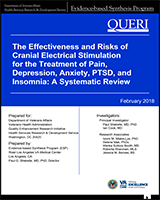NCBI Bookshelf. A service of the National Library of Medicine, National Institutes of Health.
Cranial electrical stimulation (CES) is a non-invasive method of applying low-intensity electrical current to the head. It is related to but distinct from other forms of transcranial electrical stimulation including electroconvulsive therapy, transcranial direct current stimulation (tDCS), and high-definition transcranial direct current stimulation. The different versions of transcranial electrical stimulation vary in the placement of electrodes, the intensity of the current, and the waveform of the current. According to Guleyupoglu and colleagues, CES evolved from the concept of “electrosleep,” first investigated at the beginning of the 20th century. Most of the early research and applications occurred in Russia. Beginning in the 1960s, the concept of electrosleep became more popular in the USA. Because of the belief that the treatment did not actually induce sleep, but rather the sleep was a side effect of the relaxing effect of the current stimulation, the name was changed from “electrosleep” to “cranial electrical stimulation.” Other proposed names, which have not persisted, included “transcerebral electrotherapy” and “NeuroElectric Therapy.” The latter is noteworthy because it gave its name to an early CES device, the Neurotone 101, which was the first device approved by the FDA. All subsequent CES devices have been cleared for marketing by FDA based on the concept of claiming equivalency to the Neurotone 101. The status of cranial electrical stimulation devices and FDA regulation remains a matter of some controversy.
Contents
- PREFACE
- EXECUTIVE SUMMARY
- INTRODUCTION
- METHODS
- RESULTS
- LITERATURE FLOW
- KEY QUESTION 1. Compared to usual care, what is the effectiveness of cranial electrical stimulation (CES) for the following conditions: chronic pain, depression, anxiety, PTSD, and insomnia?
- KEY QUESTION 2. Compared to usual care, what are the risks of cranial electrical stimulation (CES) for the following conditions: chronic pain, depression, anxiety, PTSD, and insomnia?
- SUMMARY AND DISCUSSION
- REFERENCES
- APPENDIX A. SEARCH STRATEGIES
- APPENDIX B. CRITERIA USED IN QUALITY ASSESSMENT
- APPENDIX C. PEER REVIEW COMMENTS AND AUTHOR RESPONSES
- APPENDIX D. EVIDENCE TABLE FOR RCTS OF CRANIAL ELECTRICAL STIMULATION BY CONDITION
- APPENDIX E. CITATIONS OF FULL-TEXT EXCLUDES
Suggested citation:
Shekelle PG, Cook I, Miake-Lye IM, Mak S, Booth MS, Shanman R, Beroes JM. The Effectiveness and Risks of Cranial Electrical Stimulation for the Treatment of Pain, Depression, Anxiety, PTSD, and Insomnia: A Systematic Review. VA ESP Project #05-226; 2018.
This report is based on research conducted by the Evidence-based Synthesis Program (ESP) Center located at the West Los Angeles VA Medical Center, Los Angeles, CA, funded by the Department of Veterans Affairs, Veterans Health Administration, Office of Research and Development, Quality Enhancement Research Initiative. The findings and conclusions in this document are those of the author(s) who are responsible for its contents; the findings and conclusions do not necessarily represent the views of the Department of Veterans Affairs or the United States government. Therefore, no statement in this article should be construed as an official position of the Department of Veterans Affairs. No investigators have any affiliations or financial involvement (eg, employment, consultancies, honoraria, stock ownership or options, expert testimony, grants or patents received or pending, or royalties) that conflict with material presented in the report.
- NLM CatalogRelated NLM Catalog Entries
- Review Classification of methods in transcranial electrical stimulation (tES) and evolving strategy from historical approaches to contemporary innovations.[J Neurosci Methods. 2013]Review Classification of methods in transcranial electrical stimulation (tES) and evolving strategy from historical approaches to contemporary innovations.Guleyupoglu B, Schestatsky P, Edwards D, Fregni F, Bikson M. J Neurosci Methods. 2013 Oct 15; 219(2):297-311. Epub 2013 Aug 14.
- Limited output transcranial electrical stimulation (LOTES-2017): Engineering principles, regulatory statutes, and industry standards for wellness, over-the-counter, or prescription devices with low risk.[Brain Stimul. 2018]Limited output transcranial electrical stimulation (LOTES-2017): Engineering principles, regulatory statutes, and industry standards for wellness, over-the-counter, or prescription devices with low risk.Bikson M, Paneri B, Mourdoukoutas A, Esmaeilpour Z, Badran BW, Azzam R, Adair D, Datta A, Fang XH, Wingeier B, et al. Brain Stimul. 2018 Jan-Feb; 11(1):134-157. Epub 2017 Oct 17.
- Cranial electrotherapy stimulation and transcranial pulsed current stimulation: a computer based high-resolution modeling study.[Neuroimage. 2013]Cranial electrotherapy stimulation and transcranial pulsed current stimulation: a computer based high-resolution modeling study.Datta A, Dmochowski JP, Guleyupoglu B, Bikson M, Fregni F. Neuroimage. 2013 Jan 15; 65:280-7. Epub 2012 Oct 5.
- Recurrent themes in the history of the home use of electrical stimulation: Transcranial direct current stimulation (tDCS) and the medical battery (1870-1920).[Brain Stimul. 2017]Recurrent themes in the history of the home use of electrical stimulation: Transcranial direct current stimulation (tDCS) and the medical battery (1870-1920).Wexler A. Brain Stimul. 2017 Mar-Apr; 10(2):187-195. Epub 2016 Nov 29.
- Review Considering the influence of stimulation parameters on the effect of conventional and high-definition transcranial direct current stimulation.[Expert Rev Med Devices. 2016]Review Considering the influence of stimulation parameters on the effect of conventional and high-definition transcranial direct current stimulation.To WT, Hart J, De Ridder D, Vanneste S. Expert Rev Med Devices. 2016; 13(4):391-404. Epub 2016 Mar 2.
- The Effectiveness and Risks of Cranial Electrical Stimulation for the Treatment ...The Effectiveness and Risks of Cranial Electrical Stimulation for the Treatment of Pain, Depression, Anxiety, PTSD, and Insomnia: A Systematic Review
Your browsing activity is empty.
Activity recording is turned off.
See more...
